 | The Xenophile Historian |

 |
 |
 |
 |
 |
 |
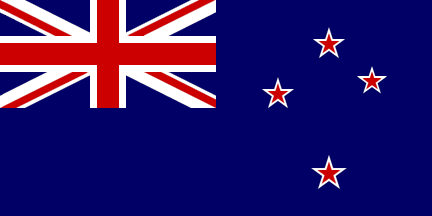 |
 |
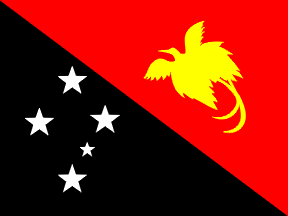 |
 |
 |
 |
 |
 |
A History of the South Pacific
Chapter 5: Oceania Since 1945, Part I

Part I
| First, A Word on the Cargo Cults | |
| The Trust Territory of the Pacific Islands, and Nearby Atolls | |
| Australia: The Menzies Era | |
| Rabbits Gone Wild | |
| Recolonial New Zealand | |
| Go to Page Navigator |
Part II
| Independence Comes to the Islands | |
Part III
| The Australian Constitutional Crisis | |
| Australia in Recent Years | |
| New Zealand: Labour and National Reforms |
Part IV
| The Smaller Island Nations Since Independence | |
| Conclusion for the Islands |

First, A Word on the Cargo Cults
One aspect of Melanesian culture that anthropologists love to discuss is "cargo cults," a term given to dozens of fringe religious movements that sprang up in the late nineteenth and twentieth centuries. Because Melanesians are divided into so many tribes and languages, the cargo cult doctrines varied from place to place; where they agreed is that they saw the possessions of the white man, which they called “cargo,” as magical items. Cult members went on to teach that the gods intended black people to have this cargo, but white people intercepted the goods, so if they built replicas of the items the cargo came from -- like dummy airplanes, landing strips and wharves -- cargo would be delivered to them, too.
Cargo cult movements got their strongest impetus during World War II, when foreign nations fought over the Melanesian islands, and war materiel was dropped from airplanes, or otherwise was left for the soldiers' use. Natives were pleasantly surprised when the American servicemen treated them as equals and shared food with them; they had never gotten along this well with Europeans. They were also amazed to see that some of the Americans were black, and that black Americans were allowed to have the same equipment as their white companions. Then when the battles were over and the soldiers left Melanesia, they scuttled boats and threw guns and jeeps into the sea, instead of trying to take the equipment with them on cargo planes -- waste on a scale that only a national government can commit. On New Guinea and the Solomon Islands, especially Guadalcanal, much of the materiel left behind went into postwar building projects; you can see it today in the World War II-era fences and Quonset huts that are still standing. All of this was very strange to people who had been in the stone age just a few years earlier.
By now the natives had enjoyed the benefits from all the goods the foreigners brought, so after the war, cargo cult followers performed whatever rituals they thought would bring the goods again. Most of these movements have faded away since the 1940s, but there is one cult hanging on in Vanuatu. This cult venerates a black American soldier named John Frum, who probably never really existed. If he did exist, the soldier may have told the natives he was “John from Texas,” or something like that, and the natives forgot the place name. However it got started, the John Frum Movement was recognized as a legitimate religion in 1956, by the Anglo-French Condominium that ruled the New Hebrides/Vanuatu at the time (see Chapter 3). On the island of Tanna, the natives believe John Frum is living in a nearby volcano, and every year on February 15, the natives stage a parade with American flags and fake rifles, and wear American-style uniforms with medals, in the hope that this year, John Frum will return to them. In modern Vanuatu, the cult even has its own political party, also called the John Frum Movement.
In Papua New Guinea, the natives also adopted one element of twentieth-century pop culture that may surprise you. One of the oldest costumed superheroes is The Phantom; comics about him were first drawn in 1936, two years before Superman, three years before the first Marvel superheroes (the Human Torch and the Sub-Mariner), and five years before Batman. Like Batman, the Phantom has no super powers, but relies on his fighting skills and his wits to defeat villains. His main trick is spreading a rumor that he is "the man who cannot die," and "the ghost who walks." American soldiers who fought on New Guinea during World War II shared some of the literature they liked to read with the natives, which included Phantom comics.
During the second half of the twentieth century, the Phantom comic strip appeared in hundreds of newspapers. Two movies were made about the Phantom (in 1943 and 1996), and in the mid-1990s he starred in an animated TV show (Phantom 2040), but since then has faded into obscurity. However, he has remained staggeringly popular in Papua New Guinea. Although the Phantom stories are set in Africa, Papuans see an immortal warrior who fights only to protect his homeland as an ideal role model. Thus, the Phantom's stories have been translated into Tok Pisin (see Chapter 1, footnote #8). Even today some New Guinea tribes make wooden shields (as art objects, not to wage war with their neighbors), and often they will paint the Phantom's picture on them as a decoration (see below).
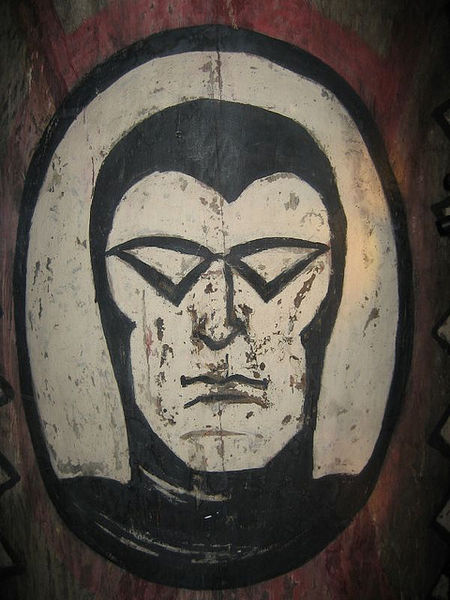
From Wikimedia Commons.
Okay, so the cargo cults are an example of how the Melanesians have employed their knowledge of Western civilization; in return, what have we learned from the Melanesians? One answer is bungee jumping. The original bungee jumpers were the so-called land divers on Vanuatu’s Pentecost Island. Here boys jump from a wooden tower, sixty to a hundred feet high, as a rite of passage, and grown men do it to prove their courage; their only protective gear is a pair of elastic vines called lianas, tied around their ankles. No doubt this is one of the most amazing death-defying ceremonies performed anywhere, and as Western man will do, he has taken the religious element and some of the danger out of the ritual, and turned it into a sport.
The Trust Territory of the Pacific Islands, and Nearby Atolls
For any readers who thought Chapter 4 of this work was too long and want the Pacific phase of World War II in a soundbite, here it is: Japan lost and the United States won. True, those nations which fought on the side of the United States also won, but only the Americans gained new territory as a result of the war; the other Allies only recovered their prewar possessions. The Japanese empire was completely dismantled and occupied by the United States, except for Taiwan, which was returned to China, and three territories that were occupied by the Soviet Union: the Kurile Islands, south Sakhalin, and the northern half of the Korean peninsula. At this point, US-controlled domains stretched all the way across the Pacific, from San Francisco to Seoul. But we saw in Chapter 3 how quickly the Americans went from being eager imperialists to reluctant ones, and though they now accepted the superpower status that came with their victories, otherwise the attitude was the same. On the Asian side of the Pacific they turned territories loose as soon as it was thought the peoples in those territories could govern themselves; they gave independence to the Philippines in 1946, South Korea in 1948, and the Japanese home islands in 1952.(1) The islands nearest to Japan were held for a generation -- it had cost thousands of American lives to take them in the battles of 1945 -- before they were returned as well.
The one newly acquired place where the Americans were willing to stay for the long haul was Micronesia. The former Japanese mandated islands had an estimated 98,100 people living on 2,180 islands and atolls, scattered across three million square miles of ocean; they were inexperienced in self-government, and the war had left them dirt poor and starving. Clearly they would need aid from a major nation, not only now but after they received independence, if that ever happened. In 1947 the United Nations declared this huge area the “Trust Territory of the Pacific Islands,” managed by the United States. Like the prewar League of Nations mandates, only temporary occupation rights were granted to the Americans, and they were expected to develop the territory for the benefit of its inhabitants. Because this area had been conquered by the fleet of Admiral Chester Nimitz in 1944, the Americans initially treated the islands like American Samoa: first the US Navy was in charge of them, and then in 1951 the islands came under the jurisdiction of the US Department of the Interior. The administrative headquarters or “capital” was first in Honolulu, then on Guam, and finally on Saipan from 1962 onward.
The US administration of the Trust Territory has been controversial, because for the rest of the 1940s and 50s the United States did not do much for the natives; the territory was managed for the benefit of the US armed forces during this time. 106 nuclear weapon tests — one tenth of all US nuclear tests – were conducted in the Pacific, nearly all in a zone of the Marshall Islands called the Pacific Proving Grounds. This included the first test explosion of a hydrogen bomb, which took place on Eniwetok (called Enewetak since independence) in 1952. 200 natives living near the test sites were forcibly moved out of fallout range. The tests went on until 1963, when the United States, along with Britain and the Soviet Union, signed a treaty banning all nuclear tests, except for those conducted underground, where the radiation can be contained.(2) Meanwhile on Saipan, Nationalist Chinese soldiers from Taiwan, a Cold War ally of the US, underwent training. For security reasons, only US citizens were allowed to visit the rest of the Trust Territory, and there were regulations on where the Micronesians themselves could travel.
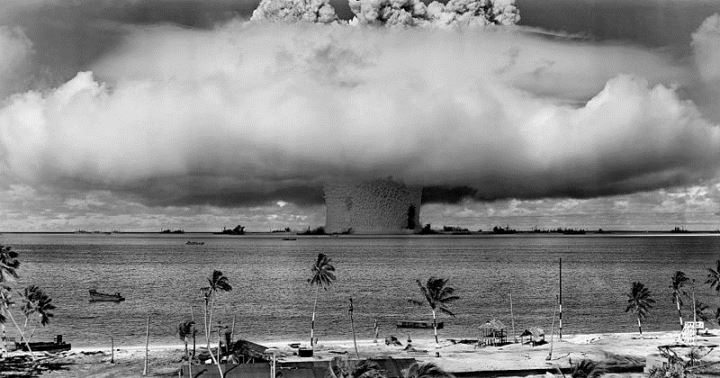
One of the nuclear tests at Bikini atoll, "Operation Crossroads Baker." From Wikimedia Commons.
Unfortunately, despite efforts to keep the natives away from radiation, and efforts to remove the radioactive waste after the testing ended, we haven’t yet heard the last word on this subject. A team of researchers visiting the nuclear test sites in 2015 found that more than half a century after the tests, Bikini Atoll still has unsafe levels of radiation.
On Enewetak, the US Defense Nuclear Agency spent eight years cleaning up. This mainly meant scraping off the atoll’s radioactive topsoil, dumping it in a crater, and covering it with an enormous concrete cap, which from a distance looks like a roofed stadium. This structure was named the Runit Dome by Americans, while locals called it The Tomb. Then Enewetak’s former residents were allowed to return, and subsequent tests reported radiation levels below the limits set by the US and Marshall Islands governments. But even now, not everyone is convinced that Enewetak is safe. The worst news is that the vine-covered Runit Dome has cracks in it, leading to fears that a future typhoon, tsunami, or rising sea levels could breach the dome and cause a major radiation leak.
In 1983 the US paid the Marshall Islands $183.7 million in damages. Most of that money went to the community hardest hit by the testing -- more than 300 people on Rongelap Atoll. In March 1954 fallout from a 15-megaton hydrogen bomb, exploded in the Castle Bravo test, blew over Rongelap, and the Americans waited until most of the locals had symptoms of radiation sickness (vomiting, diarrhea, skins burns and hair loss), before evacuating them to Kwajalein. The Atomic Energy Commission declared Rongelap safe again in 1957, but later it turned out that was not the case; over the years after the evacuees returned, occurences of thyroid tumors, miscarriages and stillbirths were much more common than in populations unexposed to radiation.
In 1999, the US approved a one-time payment of $3.8 million to the relocated people of Bikini atoll.
For the period after 1960, we have to cover how the Trust Territory islands either became independent or joined the United States, so we will return to that in another section. Instead, here we will mention two places just east of the Trust Territory that also got special treatment for military purposes: the Midway and Johnston atolls. Midway remained important for thirty years after the critical 1942 battle fought there; its naval air station continued to be used to ferry American forces to and from the conflicts in Korea and Indochina. However, Midway was no longer needed for civilian aviation, and after the Vietnam War, the military did not need it much, either, so military personnel and their families began to move away. The naval air station was officially closed in 1993, and Midway joined the rest of the Northwestern Hawaiian Islands in becoming a national wildlife refuge (see Chapter 1).
What happened to Johnston Atoll is more interesting. Located 860 miles southwest of Hawaii, and initially claimed by the United States for guano mining (see Chapter 3), it was declared a bird sanctuary in 1926, then transferred to the US Navy in 1934. After that, a vast construction project began on the largest islet in the atoll, Johnston Island. This not only included barracks and the other buildings required by a military base, but also coral and sand were dredged to enlarge the island, eventually making it big enough to support 1,000 personnel and a 9,000-foot-long runway. All this was done in the middle of the Pacific, on an island so remote that most people did not even know it existed.
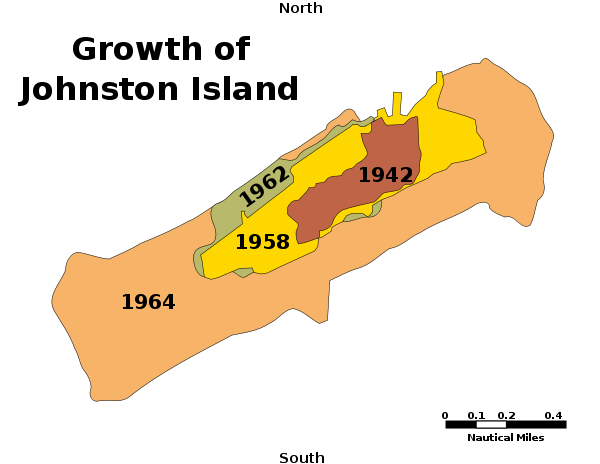
How Johnston Island grew in the mid-twentieth century. From Wikimedia Commons.
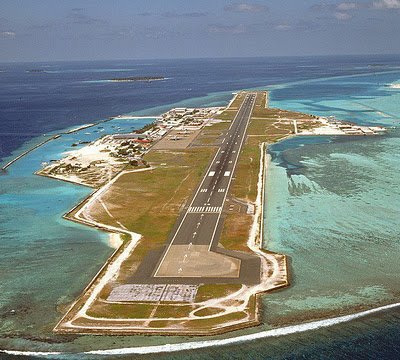
And this is how it looks from the air. Source: Ondair.net.
The Johnston Island base served the US Navy during World War II, of course, and after the war more purposes were found for it. In the early 1950s a team of rocket scientists, led by the ex-German Werner von Braun, drew up the Mars Project, a set of plans to send the first manned rockets into space. The plans proposed launching the rockets from Johnston Island for two reasons: its location in the tropics minimized the amount of fuel needed to put a rocket into orbit, and because hundreds of miles of ocean separated Johnston Island from every other place, there was no danger of a rocket falling on a populated area, in the event of a launch failure. The building of launch facilities at Cape Canaveral in Florida killed interest in turning Johnston Island into a spaceport, but a few satellites were launched from there anyway, either spy satellites or scientific payloads that needed to go into special orbits. Some atmospheric and high-altitude nuclear testing took place in the vicinity as well. And from 1971 onward, chemical weapons like Agent Orange and Sarin were moved to the island from other locations, stored here, and destroyed in a demilitarization program during the 1990s.
With the chemical weapons stockpile gone, Johnston Island’s functions were completed, and the base was closed and deserted by 2004. Because the area was contaminated by both chemicals and irradiated material from nuclear tests, visits are not allowed today, except with permission from the US Air Force. It is also likely that other activities took place here, besides the ones mentioned above -- top secret affairs that have never been declassified. Some have speculated on what those activities were; they see Johnston Island as another place like Area 51, the secret military base in Nevada that has generated conspiracy theories involving the US government and UFOs.(3) After all, we do not even know how much was spent to build and maintain the base. A few folks have compared it with Kansai Airport, which serves the Japanese city of Osaka and was also built on an artificial island; that cost about $20 billion to build. Whatever Johnston Island cost, the price tag would have been inflated by the fact that every last item and material needed -- from concrete to bulldozers to gasoline to food for the personnel – had to be transported across at least a thousand miles of ocean to get here. Think about that in your spare time!
Australia: The Menzies Era

The twin crises of the Great Depression and World War II meant that for most of the 1930s and 40s, the United States, Canada and New Zealand all had long-lived, left-wing governments that introduced major changes to national policy. Australia had a left-wing government as well, but unlike the others, it was not a strong one. John Curtin, the wartime prime minister, died in July 1945, and the main achievement of his Labor Party successor, Joseph Benedict Chifley, was to launch the greatest immigration wave Australia had seen yet, under the slogan “Populate or Perish!” The government wanted immgrants for the same reason as it had before the World Wars – most of Australia was unpopulated, especially in the north. Between 1948 and 1975, two million people moved to Australia, attracted not only by the government’s invitation, but also by the booming postwar economy. And whereas most immigrants in the past had come from the British Isles, now they also came from the non-English-speaking countries of Europe, and countries near Europe like Turkey and Lebanon. Wherever they came from, they were expected to assimilate into mainstream Australian society, just like the immigrants that went into the “melting pot” of American society, in the first years of the twentieth century.(4)
Meanwhile, a former prime minister, Robert Gordon Menzies, reorganized Australia’s conservative politicians. The United Australia Party had disintegrated during the war, and in its place, Menzies founded a new Liberal Party in 1944. Then by partnering with the Country Party, the Liberal Party won the 1949 election and installed a right-wing government. For his second time in the top spot, Menzies stayed until 1966, making him the longest-lasting Australian prime minister.
Nowadays Australians see the second Menzies administration as a golden age, because it was a long period of widespread prosperity, with jobs available for all; unemployment during this time was never more than 3%. In the commerce sector, foreign demand grew for Australia’s four primary products – wool, metals, meat and wheat – and a new crop, rice, was grown and exported to Japan. The manufacturing industry grew even more, especially in construction, because a lot of homes needed to be built. The percentage of homeowners among the population rose from barely 40% in 1947 to 75% by the time Menzies left office. Menzies encouraged this trend by introducing the Department of Housing, the Home Savings Grants Scheme, and housing loan insurance. Other benefits that raised the standard of living were tax breaks for married pensioners, “free life saving drugs,” a National Health Scheme, pensions for the disabled, and commonwealth scholarships; the later helped cause the number of universities in the country to triple.(5)
On top of everything listed above, the government launched several public works projects, starting with the completion of Canberra; we mentioned in Chapter 4 that construction in parts of the capital had to be postponed because of war and depression.(6) The School of the Air, a correspondence school based in Alice Springs, began broadcasting lessons to primary and secondary school students in the outback in 1951. The most ambitious project of all was the Snowy Mountains Scheme, a vast hydroelectric and irrigation program that called for the building of a network of dams, generators, a pumping station, tunnels, pipelines and aqueducts, in the mountains south of Canberra. More than 100,000 men from thirty nations were employed at this work, between 1949 and 1974. But while the project generated great optimisim and was seen as an example of what Australians can do when they work together, after the project was completed, it was discovered that diverting the Snowy River’s waters caused considerable environmental damage downstream; recently efforts have been made to reduce or repair the damage.
Menzies expressed a sentimental attachment to British institutions like the monarchy, but while he was in charge the main threat to Australia came from communism, so he looked to the United States for defense against the Red menace. During the 1949 election, Menzies promised to outlaw the Australian Communist Party, and though he got a Communist Party Dissolution Bill passed in 1950, it was ruled unconstitutional in court five months later. More successful was a three-way military alliance founded in 1951, called ANZUS (the initials stand for its members, A=Australia, NZ=New Zealand, and US=United States). This led to both Australia and New Zealand sending troops to fight on the side of South Korea in the Korean War, and afterwards they joined SEATO, the anticommunist alliance the Americans set up for Southeast Asia. Then because of their ANZUS and SEATO commitments, Australia and New Zealand fought alongside the Americans in Vietnam, too.
Australian involvement in Vietnam began with the sending of thirty military advisors in 1962, and after the Americans fully committed themselves to the war effort in 1965, Menzies introduced conscription to make sure Australia had enough troops. Since that was his last full year in office, Menzies left to his successors the unenviable task of cutting back Australia’s involvement when they realized they would not win the war. Meanwhile, the antiwar movement split Australia, just as it put the United States in chaos; it was the worst opposition to Australia’s foreign wars since World War I.(7)
Rabbits Gone Wild

In the previous chapter we looked at how the prickly pear cactus grew out of control in the late nineteenth-early twentieth century. Unfortunately, the story of invasive species did not end there. With the possible exception of man, the rabbit is the most devastating life form that is not native to the continent. Like the prickly pear, the first rabbits came to Australia with the first convicts/settlers. They were meant to be a food source, like the other animals brought that early, but we do not hear from them again until 1827, when a newspaper in Tasmania reported a local population explosion of bunnies. Apparently on the Australian “mainland,” the dingoes got the few rabbits which escaped from cages or rabbit-warrens. It looks like the balance of nature was tipped in 1859; in that year Thomas Austin, an English settler whose hobby was hunting, imported twenty-four wild rabbits and released them on his property in Victoria. These rabbits came from a hardier breed than the others, and bred like, well, rabbits. They were so prolific, in fact, that ten years later, two million wild rabbits were shot and trapped, but it had no observable effect on the population.
Rabbits were hunted for food and pelts during economic hard times, especially during the depression of the 1890s, but they also ate local plants and tree seedlings on such a large scale that they stripped the ground bare in many places, and then the ground was ruined by wind and water erosion. This hurt crop production and ranching, and threatened the bandicoot, a rabbitlike marsupial the rabbits competed with. Rabbits were reported in New South Wales in 1880, in South Australia and Queensland in 1886, and Western Australia in 1890. Efforts were made to stop rabbit expansion by building fences across Queensland and Western Australia; the longest fence (see below) was built between 1901 and 1907, and went all the way across the continent. The fences didn’t work, because some rabbits made it over to the protected side before they were completed, and others managed to dig under them. By the 1920s, the rabbit population was estimated at ten billion.
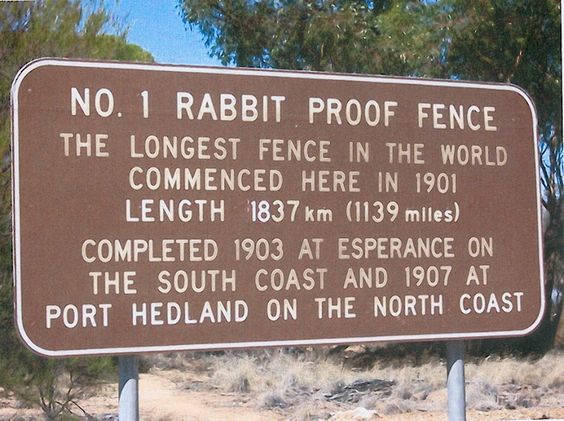
Conventional controls were tried on the rabbits: shooting, trapping, destroying burrows/warrens with bulldozers, fire, and poison. These methods worked, but they required a lot of labor, so a search was made for biological controls, like the one that took care of the prickly pear. Eventually scientists settled on the myxoma virus, found in South America. Several years of testing took place, and in 1950 the virus was released into the wild. Initially the results were terrific; in some places 99 percent of the rabbits died from myxomatosis. But since the disease was spread by mosquitoes, and mosquitoes need water to breed, rabbits living in the driest parts of the continent were not exposed to it. Also, during the 1950s and 1960s some rabbits acquired genetic immunity to the virus; today about 60 percent of Australian rabbits are immune.
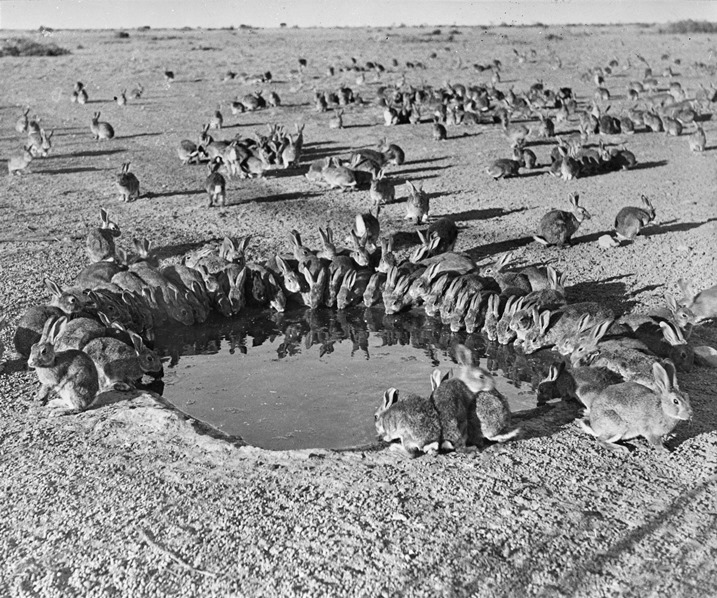
A horde of wild rabbits around a water hole near Adelaide, in 1938. It was in this area that myxomatosis was first tested. From Wikimedia Commons.
Another deadly ailment, rabbit haemorrhagic disease (RHD), was released in Australia in 1995. This disease was spread by flies, so it did better in arid areas than myxomatosis, killing off 90 percent of those rabbits. However, RHD did not spread as well in cooler, wetter areas, like on the coast, and now the rabbits are becoming immune to it as well.
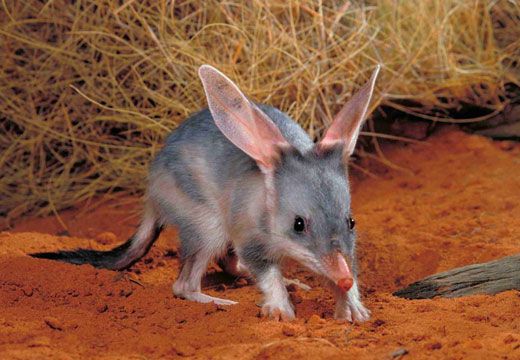
Australians don’t like the idea that rabbits are cute and cuddly, because of the damage rabbits have inflicted on their country. To stop promoting rabbits, and to help save the bandicoot, or bilby (see the above picture), which is endangered because of rabbits, Australian conservationists are now urging people to replace the Easter Bunny with the "Easter Bilby."
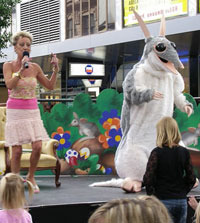
However, I think the mascot needs a bit of work. From Rabbit Free Australia.
And that’s not all; there have been rabbit outbreaks on the subantarctic islands between New Zealand and Antartica. Nobody lives here because of the miserably cold climate, but in the early nineteenth century, the seal hunters who came to New Zealand also came here. The largest island in these waters, Macquarie Island, belongs to Australia rather than New Zealand, and the hunters who came here bagged a tremendous number of seals and penguins.(8) Unfortunately, their ships also brought rats and mice, which went ashore and thrived. Soon the rodents became a problem, so the seal hunters introduced cats to Macquarie Island, because on a ship, a cat is the only mousetrap you need. Then in 1870, after a few shipwrecks took place on the subantarctic islands, some rabbits were turned loose to provide food for any future shipwreck survivors. That ruined the rodent control program, because the cats added rabbit to their diet, and caught fewer rats and mice. Even worse, the cats did not kill enough rabbits to stop their multiplication, and the feral cat population jumped as well, now that there was plenty of food for the cats to eat. In addition, the cats also preyed on the native bird population; eventually they wiped out two species.
Nobody seems to have learned from the ecological damage already caused by introducing new animals to the South Pacific, because the folks involved on Macquarie Island kept introducing new species to control the ones which had become pests. The next person with a bright idea (sarcasm intended) brought stoats, British weasels, to control the rabbits, since the cats weren’t doing a very good job, but instead the stoats went after seabirds and their eggs. At some point Australian possums arrived on the island – I couldn’t find out who introduced them or why – and because the cats and stoats weren’t interested in them, the number of possums grew to pestilential levels, too. Macquarie Island was declared a wildlife sanctuary in 1933, meaning the hunting of seals and penguins stopped, but the plague of rabbits continued after that. By 1978, there were an estimated 130,000 rabbits on the island, and 500 feral cats.
At this point, the Australians tried to end the rabbit plague by introducing a real plague: myxomatosis. It reduced the rabbit population to less than 20,000, but just like on the Australian mainland, the rabbits that survived were immune to the disease. The cats responded to this loss of food by hunting birds instead of rabbits, killing as many as 60,000 per year. This made the cats the new main pest on the island, so in 1985 the government gave the conservationists permission to hunt the cats. By shooting them and using traps and dogs, the hunters were successful; the last cat was killed in 2000.
Alas, even now people couldn’t stop messing with Mother Nature. With no cats or myxomatosis to keep their numbers in check, the rabbits experienced another population explosion. This time, the rabbits ate so much of the local vegetation that the resulting erosion caused a landslide, which killed most of a penguin colony in 2006. At this point the Tasmanian government decided that the only way to protect the native species was to eradicate all non-native species. Accordingly, in 2007 the Australian and Tasmanian governments spent $25 million to kill every mammal on the island, except for the seals. First poisoned bait was dropped from helicopters, and then hunters with dogs went in to get any surviving rodents, rabbits, possums and stoats. The last pests were caught in 2011, and after a thorough search all over the island did not find any more, the world’s largest pest eradication program was declared a success in April 2014.
Now that Macquarie Island’s pests are all gone, will the native ecosystem recover to anything like it was before 1800? We will have to wait at least twenty years to find out. In the meantime, the conservationists keep a few traps on the island in case any pests are re-introduced, and New Zealand is looking to follow Australia’s example in getting rid of its own pests. As I write this, a project to eradicate the mice on the Antipodes Islands is in progress, and New Zealand has committed $28 million to a plan called Predator Free New Zealand Ltd., where the goal is to rid the whole country of possums, rats and stoats by 2050. In this part of the world, being a conservationist means you have to kill one animal to save another.
I guess there are two morals to this story. You have probably guessed the first: think twice before introducing a new plant or animal to an environment that doesn’t already have it. The other is that in Australia deadly snakes and spiders get the most attention, but you will face challenges from many creatures, and not all of them look dangerous.(9) As I wrote this chapter, I learned that native parrots (cockatoos, cockatiels and budgies), like the emus, have become pests since they added the crops of farmers to their diet. And in the state of Victoria, a new pest has just appeared – tumbleweeds!
Recolonial New Zealand

At the end of Chapter 3, we saw that when Britain ended colonial rule, New Zealand chose to become a separate country from Australia because New Zealanders considered themselves different; “a better type of Britisher” were the words used. The twentieth-century standard of living was generally better than it was in Great Britain, and so were the welfare and education systems, so a case could be made that the Kiwis were even better than their kin in the mother country. The relationship between New Zealand and Britain was called “recolonial,” because as noted in Chapter 4, New Zealand willingly continued to grow food to feed Britain, and sent soldiers to fight on the side of Britain in both World Wars. In 1953 Edmund Hillary, a beekeeper from New Zealand, became one of the first two men to climb all the way up Mt. Everest; the other was Nepal’s Tenzing Norgay (see both of them in the picture below). Because Britain’s Colonel John Hunt led the expedition, and the news reached London right before Queen Elizabeth II’s coronation, both New Zealand and Britain shared the glory of that achievement.
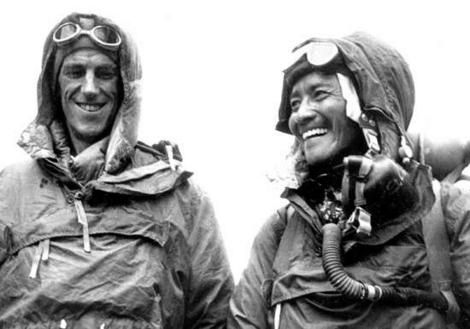
In 1931, Britain’s Parliament had passed the Statute of Westminster, which granted full internal and external autonomy, and Commonwealth membership, to the Dominions within the British Empire, like Canada. New Zealand waited until 1947 to ratify the statute, but even so, this was just a formality; the two governments gave their approval to a political situation that had already existed for forty years. And then New Zealand and Britain continued to act like they were one country until the 1970s, when their foreign policies began to pull them in different directions.
After World War II, New Zealanders got tired of a left-wing, activist government, and in 1949 voters retired the Labour Party and their wartime prime minister, Peter Fraser. For the next thirty-five years (1949-84), the right-wing National Party was usually in charge. The main prime ministers from the National Party were Sidney Holland in the 1950s, Keith Holyoake in the 1960s, and Robert Muldoon in the late 1970s-early 1980s. Twice the Labour Party managed to regain control (1957-60 and 1972-75), but in both cases the Labour administration did not handle economic and political issues as well as its National Party predecessor, so each Labour government lasted for just one term.
Meanwhile, New Zealand society remained more conservative than Australian and British society; foreigners viewed it as downright puritanical. As the travel website Lonely Planet put it:
“Until the 1950s, it was technically illegal for farmers to allow their cattle to mate in fields fronting public roads, for moral reasons. The 1953 American movie, The Wild One, was banned until 1977. Sunday newspapers were illegal until 1969, and full Sunday trading was not allowed until 1989. Licensed restaurants hardly existed in 1960, nor did supermarkets or TV. Notoriously, from 1917 to 1967, pubs were obliged to shut at 6pm. Yet the puritanical society of Better Britons was never the whole story. Opposition to Sunday trading stemmed, not so much from belief in the sanctity of the Sabbath, but from the belief that workers should have weekends too. Six o’clock closing was a standing joke in rural areas, notably the marvellously idiosyncratic region of South Island’s west coast. There was always something of a Kiwi counterculture, even before imported countercultures took root from the 1960s.”(10)
It was a terrible shock for New Zealand when Britain joined the European Union, then called the Common Market, in 1973. British demand for New Zealand farm products dropped, now that they could be obtained from Continental Europe for the same price or less. Also, this happened at the same time as the first OPEC price increases on crude oil, so the New Zealand economy was hit in two ways. New Zealand responded by looking for other markets for its products, and by promoting tourism. At the time of this writing (2016), Britain has just voted to leave the European Union again, so after “Brexit,” relations between New Zealand and the mother country may be restored to a level comparable to where they were before 1973.
The tourism industry is one of the latest success stories for New Zealand. Only 36,000 tourists came to New Zealand in 1960, but now more than two million visit every year. Two things caused this jump. One was the invention of jet airliners that could carry hundreds of passengers on nonstop flights from Australia, Asia and even the Americas. The other was the decision to film movie versions of J. R. R. Tolkien’s novels (The Hobbit and The Lord of the Rings) in rural areas of New Zealand. Nowadays fans of those movies come to New Zealand to see The Shire and other filming locations. Air New Zealand got in on the act, with fantasy-themed safety videos like this “unexpected briefing”:
If you have seen the movies, you’ll recognize the director, Peter Jackson, as one of the passengers.
This is the end of Part I. Click here to go to Part II.

FOOTNOTES
1. Since the Cold War came immediately after World War II, the Americans kept military bases in those countries after they got governments of their own. The two main bases in the Philippines, Clark Air Force Base and Subic Bay, were closed in the early 1990s, while the bases in South Korea and Japan are still in use.
2. The United States was not alone in doing this. France and Britain also conducted their share of nuclear weapons testing in the Pacific, once they acquired the technology to make the bombs. Britain did some testing on the Australian mainland as well as in the Pacific, but stopped in 1962 when the United States allowed British underground testing at American sites in Nevada. France conducted most of its nuclear tests in French Polynesia, between 1966 and 1996; unlike the US and UK, France did not sign the 1963 treaty banning above-ground tests. And now it appears that the tests dropped more radioactive fallout on Polynesia than the French ministry of defense had admitted previously.
3. The most popular theory is that the island’s long runway gave spy planes a place to take off and land without being seen.
4. However, the immigrants were still expected to be white. Arthur Calwell, Chifley’s Immigration Minister, was a strong supporter of the White Australia policy (see Chapter 3), and he deported the Chinese and Southeast Asian refugees who had fled to Australia to escape the recent war, even if they had married Australian citizens and started families since their arrival. Calwell justified the deportations with a bad joke: “Two Wongs do not make a white.”
5. Australia got some good publicity in 1956, when the Summer Olympic Games were hosted by Melbourne. I suspect the Melbourne-Sydney rivalry is the reason why Sydney was the host, the next time the games came to Australia (in 2000).
6. Several government agencies had to wait until the 1950s before they could move to Canberra, because their offices were incomplete. In the meantime, they operated from either Sydney or Melbourne. The last governmental body to arrive was the High Court of Australia, which moved to Canberra in 1980. Previously the High Court had been in Melbourne most of the time, but an attempt was made to have the Court hold sittings in each state capital during a typical year.
7. The Australian government claimed that it entered the war because the South Vietnamese president, Ngo Dinh Diem, requested Australian troops. However, in 1995 the Cabinet papers were opened and it was discovered that this statement was in fact false; what Diem really did was try to dissuade Australia from getting involved.
8. The discoverer of Macquarie Island, Captain Frederick Hasselborough of the HMS Perseverance, claimed he saw a wreck “of ancient design,” suggesting that some other people, perhaps the Polynesians, had come here before he made landfall in 1810. Obviously, whoever owned that boat did not stick around. Since this happened during Australia’s colonial era, somebody proposed building a penal settlement here, like the ones on Australia and Tasmania, but the island’s remoteness, combined with the stormy weather it routinely experienced, caused the plan to be rejected. In an age when most criminals were treated harshly, exile to a place like Macquarie Island was seen as too brutal!
9. In 2012, flooding on the Murrumbidgee River caused a plague of spiders to take over Wagga Wagga; so many arrived that their webs looked like snow on the town. Fortunately, these weren’t the kind of spiders that bite, like the notorious redback.
10. One consequence of the puritanism described in the above paragraph is that until 2005, the country had no laws to keep adult women from sexually abusing children. This is because the legal definition of rape only applied to men; supposedly women were not capable of committing rape, statutory or otherwise. Stacey Friel, a twenty-one-year-old swimming teacher, was aware of this, and had an affair with a thirteen-year-old student. When she was caught in 2003, the only punishment was a twelve-month suspension from coaching, and that was done because the student-teacher relationship gave her swimming team a bad name. Subsequent legislation changing the definition of rape failed to pass, but adult women molesting boys can now be charged with "sexual violation." Still, the courts are free to choose whatever sentence they want for each conviction.
Support this site!

PAGE NAVIGATOR
A History of the South Pacific
|
Other History Papers |
Beyond History
|
